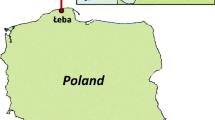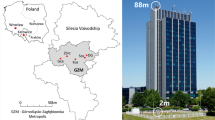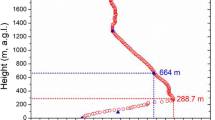Abstract
Thermal stratification of the lower 800-m air layer over Moscow, including distribution functions of inversion heights and duration, has been studied in detail based on ECHO-1 sodar data. The distribution of the bottom height of elevated inversions, unlike the thickness of surface inversions, is bimodal, which reflects the diversity of their origin. The lifetime of morning elevated inversions (remains of night surface inversions) is, on average, ~3 h, and, in some cases, over 6 h; their bottom heights usually do not exceed 350 m. Superlong elevated subsidence inversions are more often observed in Moscow from November to February and may be detected on sodar records continuously up to 120 h. The influence of retentive inversion layers on the surface content of trace gases in the atmosphere over Moscow has been studied based on the 2002–2016 data. The final destruction of morning elevated inversions results in a rapid acceleration of increase in the content of O3 and a start of decrease in the content of NO2 in the atmospheric surface layer. Both effects reflect the intensification of a vertical turbulent exchange. Such a rapid increase in the rate of growth of ozone after the inversion destruction is not associated with its photochemical generation and is apparently the result of dynamic processes (increased downward ozone fluxes from upper air layers). In contrast, under the conditions of long-lived elevated subsidence inversions in fall and winter, no statistically significant variations in the surface contents of five trace gases (O3, NO, NO2, CO, and SO2) have been found.





Similar content being viewed by others
REFERENCES
N. P. Krasnenko, Acoustic Sounding of the Atmospheric Boundary Layer (IOM SO RAN, Tomsk, 2001) [in Russian].
E. H. Brown and F. F. Hall, “Advances in atmospheric acoustics,” Rev. Geophys. Space Phys. 16 (1), 47–110 (1978).
M. A. Lokoshchenko, “Use of vertical sodars in meteorology (a review),” Atmos. Oceanic Optics 9 (7), 616–628 (1996).
M. A. Lokoshchenko, “Temperature stratification of the lower atmosphere over Moscow,” Russ. Meteorol. Hydrol. 32 (1), 35–42 (2007).
E. Yu. Bezuglaya, Meteorological Potential and Climatic Features of Urban Air Pollution (Gidrometeoizdat, Leningrad, 1980) [in Russian].
N. P. Krasnenko and M. G. Fursov, “Remote acoustic monitoring of meteorological variables in the atmospheric boundary layer,” Atmos. Oceanic Optics 5 (6), 652–654 (1992).
P. B. Russell and E. E. Uthe, “Acoustic and direct measurements of atmospheric mixing at three sites during an air pollution incident,” Atmos. Environ. 12, 1061–1074 (1978).
B. E. Prater and J. J. Colls, “Correlations between acoustic sounder dispersion estimates, meteorological parameters and pollution concentrations,” Atmos. Environ. 15 (5), 793–798 (1981).
E. Yu. Bezuglaya, “Lower tropospheric inversions and their influence on Moscow air pollution,” Tr. Gl. Geofiz. Obs. im. A.I. Voeikova 207, 202–206 (1968) [in Russian].
S. P. Singal, B. S. Gera, and D. R. Pahwa, “Application of sodar to air pollution meteorology,” Int. J. Remote Sens. 15 (2), 427–441 (1994).
M. A. Lokoshchenko, N. Ph. Elansky, and N. V. Semenova, “Influence of thermal stratification on morning growth of surface ozone,” in Proceedings of the 12th ISAR-S (Cambridge, UK, 2004), Addendum, pp. 27–30.
M. A. Lokoshchenko, N. V. Semenova, A. A. Isaev, N. N. Sarana, I. B. Belikov, N. F. Elanskii, and A. I. Skorokhod, “Use of acoustic remote sensing for investigations of elevated inversions and their influence on ground air pollution,” in Proceedings of the XV Session of the Russian Acoustic Society (GEOS, Moscow, 2004), Vol. 2, pp. 117–121 [in Russian].
N. F. Elansky, M. A. Lokoshchenko, A. V. Trifanova, I. B. Belikov, and A. I. Skorokhod, “On contents of trace gases in the atmospheric surface layer over Moscow,” Izv., Atmos. Ocean. Phys. 51 (1), 30–41 (2015).
M. A. Lokoshchenko, A. Yu. Bogdanovich, and N. F. Elansky, “Temperature stratification impact on the composition of surface air according to data of acoustic sounding of the atmosphere,” in Proceedings of the XXXII Session of the Russian Acoustic Society (Moscow, 2019), pp. 065–069 [in Russian].
M. A. Lokoshchenko, “Wind regime in the lower atmosphere over Moscow from the long-term acoustic sounding data,” Russ. Meteorol. Hydrol. 39 (4), 218–227 (2014).
G. M. Abakumova, E. V. Gorbarenko, E. I. Nezval’, and O. A. Shilovtseva, Climatic Resources of Solar Energy of the Moscow Region (Librokom, Moscow, 2012) [in Russian].
M. M. Rykachev, “Some results of studies of different atmospheric layers, conducted with the help of kytes from 1904 to 1911,” Geofiz. Sb. 1 (1), 75–113 (1914).
G. B. Mashkova, “Description of raised inversions in the lower 300-m atmospheric layer,” Tr. IEM 6 (44), 80–88 (1974) [in Russian].
Typical Characteristics of the Lower 300-m Atmospheric Layer from High-Altitude Mast Measurements, Ed. by N. L. Byzova (Gidrometeoizdat, Moscow, 1982) [in Russian].
M. A. Lokoshchenko, “Acoustic sounding of lifted inversions,” Russ. Meteorol. Hydrol., 7, 17–26 (1994).
Climatic Characteristics of Pollutant Transport in the Atmosphere: A Handbook, Ed. by E. Yu. Bezuglaya and M. E. Berlyand (Gidrometeoizdat, Leningrad, 1983) [in Russian].
Characteristics of Temperature in the Lower 600-m Atmospheric Layer from MTP-5 Profiler Data: A Handbook (Rosgidromet, Moscow, 2012) [in Russian].
M. A. Lokoshchenko, “Investigation of surface inversions by acoustic sounding method,” Russ. Meteorol. Hydrol., No. 6, 27–36 (1994).
P. Brimblecombe, Air Composition and Chemistry (Cambridge University Press, Cambridge, 1986; Mir, Moscow, 1988).
A. D. Danilov and I. L. Karol’, Atmospheric Ozone, Sensation and Reality (Gidrometeoizdat, Leningrad, 1991) [in Russian].
T. E. Graedel and P. J. Crutzen, Atmospheric Change: An Earth System Perspective (W.H. Freeman and Company, New York, 1993).
U. Neu, T. Kunzle, and H. Wanner, “On the relation between ozone storage in the residual layer and daily variation in near-surface ozone concentration: A case study,” Boundary-Layer Meteorol. 69 (3), 221–247 (1994).
ACKNOWLEDGMENTS
We thank A.V. Kochin and V.L. Fomenko from the Central Aerological Observatory and Ye.I. Nezval’ for providing radiosounding and UVR data, as well as colleagues from the MSU MO; the Moscow Ecological Monitoring network; and the Institute of Atmospheric Physics, Russian Academy of Sciences, for their assistance.
Author information
Authors and Affiliations
Corresponding author
Additional information
Translated by B. Dribinskaya
Rights and permissions
About this article
Cite this article
Lokoshchenko, M.A., Bogdanovich, A.Y., Elansky, N.F. et al. Thermal Inversions and Their Influence on the Composition of the Surface Air Layer over Moscow. Izv. Atmos. Ocean. Phys. 57, 559–567 (2021). https://doi.org/10.1134/S0001433821060086
Received:
Revised:
Accepted:
Published:
Issue Date:
DOI: https://doi.org/10.1134/S0001433821060086




